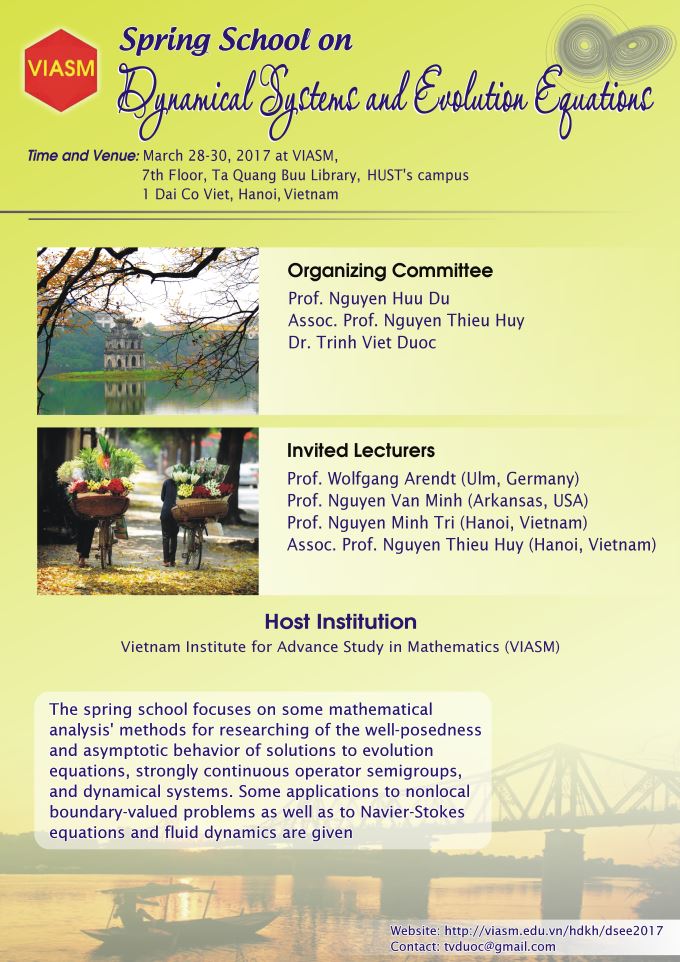Spring School on "Dynamical Systems and Evolution Equations"

Time:09:00:28/03/2017 to 16:00:30/03/2017
Venue/Location: C2-714
Organisers: Prof. Nguyễn Hữu Dư, Assoc. Prof. Nguyễn Thiệu Huy, Dr. Trịnh Viết Dược
Purpose: The spring school focuses on some mathematical analysis’ methods for researching of the well-posedness and asymptotic behavior of solutions to evolution equations, strongly continuous operator semigroups, and dynamical systems. Some applications to nonlocal boundary-valued problems as well as to Navier-Stokes equations and fluid dynamics are given.
Invited Speakers: Prof. Wolfgang Arendt, Prof. Nguyễn Văn Minh, Prof. Nguyễn Minh Trí, Assoc. Prof. Nguyễn Thiệu Huy
Content:1) Nguyen Van Minh: Some approaches in mathematical analysis for the study of asymptotic behavior for solutions to dynamical systems
We introduce some approaches using mathematical analysis in researching for asymptotic behavior of solutions to dynamical systems. The mentioned methods are including: spectral theory of functions and sequences, relations between the spectra of solutions and that of the operators appearing in dynamical systems.
2) Wolfgang Arendt: Semigroups generated by non-local boundary conditions: Well-posednesss and asymptotics.
For each point z of the boundary of a bounded domain in the euclidean plane a Borel measure µ(z) on the entire domain is given. A function defined on the closure of the domain satisfies non-local Dirichlet boundary conditions if the function at a point z of the boundary equals the integral of the function over the entire domain with respect to the given measure µ(z) .
We prove that the Laplacian under these boundary conditions generates a holomorphic semigroup on the space of all continous functions defined on the closure of the boundary. The holomorphic estaimate is challenging. Another difficulty is that the semigroup is not strongly continuous at zero , and finally we obtain compactness by unsusual arguments. In conlusion, we finally can prove existence and uniqueness of the corresponding parabolic problem and show that all solutions converge to an equilibrium.
Similar results hold for non-local Robin boundary conitions. However, for that case completely different arguments are used. In fact, Greiner's perturbation theory for boundary conditions fits very well for this case, once it has been adapted to non-densely defined operators.
3) Nguyen Minh Tri (joint work with D. Q. Khai): Well-posedness for the NavierStokes equations with data in homogeneous SobolevLorentz spaces
In this talk, we give a brief introduction of the setting and history of the Navier-Stokes equations (NSE). Next, we recall some results by Kato and several other experts, including ours, on mild solutions of NSE. Finally, we present some new results, obtained joinly with D. Q. Khai, on the local well-posedness for the NSE with arbitrary initial data in homogeneous Sobolev-Lorentz spaces. Our new results improve the previous ones by several authors including see Cannone (1995), Cannone and Meyer (1995), Chemin (1992). In the case of critical indexes, we prove global well-posedness for NSE provided the norm of the initial value is small enough. This result is also a generalization of those obtained by Cannone (1997), Kozono and Yamazaki (1995) and Meyer (1999).
4) Nguyen Thieu Huy: Semigroups, Interpolations and Stability of Solutions to Fluid Flow Problems
In 1991, when looking for periodic solutions to Navier-Stokes equations on the whole space, Maremonti announced an important problem related to bounded solutions of Navier-Stokes equations in unbounded (in all directions) domains saying that
“Theorem A. Denote by f the body force and u(t,x) a solution to the Navier-Stokes equations, X and Y two Banach spaces with norms ||.||X and ||.||Y respectively. If ||f (t,.)||X is uniformly bounded in time, then so is ||u(t,.)||Y.” If the domain is bounded (in some direction), then using the Poincare inequality and/or some compact embeddings it is convenient to prove the validity of Theorem A. The situation becomes more complicated when one considers the unbounded domain in all directions since the Poincare inequality is no longer true and compact embeddings are not valid. Therefore, some new approaches have been introduced to overcome this difficulty.
Maremonti used some geometric properties of the domains such as the symmetry and/or the smallness of the complement of such domains to show the validity of Theorem A. Galdi and Sohr discovered the fact that the specific structures of the phase-spaces X and Y played important roles when looking for bounded solutions to Navier-Stokes equations in exterior domains. Consequently, they introduced some relevant function spaces featuring the decay of the solutions at spatial infinity to prove Theorem A on an exterior domain without restricted conditions on the domain. The last approach that we would like to mention was given by Yamazaki and exploited the interpolation features of the weak-Ld spaces to prove the existence of bounded (in time) weak mild solutions of Navier-Stokes equations on exterior domains for each bounded external body force. This approach has then been extended by myself to obtain bounded strong mild solutions in weak-Ld spaces of Navier-Stokes equations around rotating obstacles. In this lecture, a general framework will be introduced to study the Theorem A on an exterior domain for general semi-linear evolution equations in which the linear part generates a strongly continuous semigroup satisfying the Lp-Lq smoothing properties, and the nonlinear term is locally Lipschitz. Using the interpolation functors combined with differential inequalities and fixed point arguments we are able to prove the existence of a bounded (in time) solution for each bounded external body force. Moreover, our methods can be extended to obtain the stability of such bounded solutions. Applications to fluid flows around rotating obstacles and to Navier-Stokes-Oseen equations will be given.
Language: English and Vietnam
Tentative schedule: 28/3 - 30/3.
Contact: tvduoc@gmail.com

